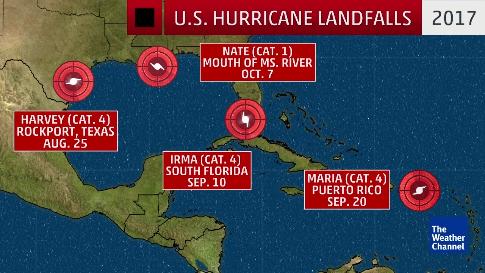Intense 2017 Hurricane Season Attributed to Global Warming

From Harvey to Irma to Jose to Maria to Nate, and now Ophelia battering Ireland of all places, this truly devastating hurricane season is currently affecting the lives of millions, maybe even tens of millions of people. Four powerful hurricanes have impacted the Atlantic and the United States in less than one month. It’s extremely scary to hear about the damage that was caused by the wake of these dangerous storms. Lives were upturned; memories were lost as personal possessions were demolished. Ordinary people died as a result of the hurricanes, and structures were annihilated.
The first major storm that arrived was Hurricane Harvey, which made landfall in southeast Texas on Aug. 25 and dropped more than four feet of water into the area. The Category 4 hurricane destroyed over 100,000 homes, claimed more than 80 lives, and inflicted billions of dollars in damage.
What set this storm apart was that it stalled once it made landfall. Harvey stayed in place, dropping over four feet of rain water and transforming public roads into rivers and lakes. Imagine homes completely flooded to the point where almost all possessions are lost and the inhabitants must either stay upstairs, climb on rooftops, evacuate to a shelter or a different area, or find a new home. Additionally, the rising waters submerged approximately half a million vehicles. Today, some communities are still covered with floodwaters, now a toxic mix of sewage and petrochemicals.
The next hurricane that arrived was Irma, which was the strongest Atlantic basin hurricane ever recorded outside the Gulf of Mexico and the Caribbean Sea. It devastated islands in the Caribbean beginning Sept. 6, and came ashore in Florida on Sept. 10. Fifteen million Floridians, or three-quarters of the state’s population, felt the wrath of mother nature as they lost power. Irma broke several world records; it stayed a Category 5 for three days, the longest Category 5 since satellite storm tracking began. Irma spun so powerfully in the Caribbean’s Leeward Islands as a Category 5 that sustained 185-mph winds for 37 hours, longer than ever recorded worldwide.
The storm also hit way too close to home. At one point, Palm Beach County was predicted to be the target of the worst section of the hurricane: the right side. Fortunately, the storm veered more to the west coast, so Palm Beach County was not impacted as terribly and received less than Category 1 or 2 force winds.
However, the entire state of Florida was covered by the massive storm, causing floods and uprooting trees while knocking out electric power to millions. Here in Palm Beach County, schools were out of session for seven days, and students will now be required to make-up three of those days during previously scheduled teacher-work/PDD days. Unfortunately, the west coast of Florida was hit hard (Category 3 or 4 depending on the area of the state, with indescribable damage done to the Florida Keys and Naples.
Olympic Heights sophomore Madeline Chamorro particularly had a dreadful experience during Hurricane Irma. Her home, like numerous others in Boca Raton, lacked power for approximately six days, and she was forced to subsist in the sweltering heat of a home with no air-conditioning, where outside temperatures were in the high 80s and 90s.
“It became unbearable to live without air-conditioning for almost a week,” Chamorro describes. “The week was full of complaining and boredom, there was nothing to do but play board games, and the hurricane made my family live like survivalists. All the food spoiled, and I had to shower with cold water every hour to keep cool.” Madeline’s story exemplifies the terrible conditions that many of us had to deal with, but her home also underwent structural damage as the storm destroyed her fence.
The models were so unreliable before the storm because they kept shifting direction every update. People would evacuate to different sections of the state and some even evacuated to other states. Numerous residents of South Florida evacuated from their homes to the west side of Florida to avoid Irma, only to be affected by it even more.
Broward county resident Lisa Smith decided to leave her home with her husband and three children and drive to Tampa to escape the storm. “When we saw the latest models travel along the east coast, we packed up all our things and went to Tampa,” Smith explains. “Then once we got to Tampa, we noticed that the tracks all traveled along the west coast and headed right towards Tampa. So, we packed up again and went back to Broward.” This example illustrates the utter confusion that was taking place during this terrible time.
The next storm on the seemingly never-ending list was Jose, which was active during Ima’s reign as first a tropical storm and then a Category 4 hurricane. It lasted over 12 days and impacted the northeastern coast of the United States as high waves and small storms. The storm passed north of the Caribbean and Puerto Rico as a Category 4 and had a very interesting track. Jose made loop de loops as it moved, and it stayed in place as it kept spinning at times. It changed from Category 4 to tropical storm, then a Category 1 and then back to a tropical storm and delivered tropical storm force conditions to New England and the northeastern coast.
Jose was followed by Maria, a powerful category 5 hurricane that slammed the small island of Dominica on September 18, Puerto Rico on September 20, and other Caribbean entities. Maria was the strongest storm to hit Puerto Rico in over 80 years. Puerto Rico is now experiencing a humanitarian crisis, and the U.S. territory is expected to persist without power for months.
Maria not only brutally affected people living on the islands, but American tourists as well. In Dominica, it has been reported that two locals from Palm Beach County remained on the island during the storm and were trapped inside of a hotel, unable to escape. Storm and surge watches were even enacted for part of the North Carolina coast and surrounding areas as Maria approached.
What is the cause for the recent surge in hurricane activity? How is it possible that four major storms made landfall before October – the typically most violent month for hurricanes? Well, the answer simply lies with global warming.
Scientists have studied the effects of climate change on the world’s oceans and found a correlation between higher ocean temperatures and storm intensity. Professor Richard Allan from the department of meteorology at the University of Reading in the United Kingdom claims that hurricanes “will undoubtedly be slightly more severe due to the extra heat content in the ocean due to the long-term warming of the climate.” He also elucidates how this year there has been a lack of upper-level wind flow or lower pockets of moisture that can erode these storms, therefore leading to huge, catastrophic and nightmarish hurricanes that we must deal with.
In scientific terms, rising temperatures from climate change/the warming of the Earth lead to warmer air holding more moisture, which causes more intense downpours in a hurricane. These deadly storms are essentially natural heat engines that feed off energy from warm, moist air over the tropical and subtropical oceans.
The melting of ice glaciers due to the greenhouse effect will also increase sea levels, thus, intensifying storms. Kerry Emanuel, a renowned atmospheric scientist at the Massachusetts Institute of Technology (MIT) explains, “The warming of the climate has increased the underlying probabilities of very heavy rain events like happened in Harvey and very high category hurricanes like Irma.” The increased temperature of the Earth is due to the abundance of greenhouse gases gushing into the atmosphere. Scientists maintain that two centuries of human-induced fossil fuel burning have altered temperatures to make relentless storms like Harvey, Sandy (which hit the northeast U.S. in 2012), Irma, and the rest worse.
Even world leaders like Pope Francis have responded to the threat of global warming. He declares, “Those who deny climate change need to go to scientists and ask them.” He says that climate change is a “serious matter over which we cannot make jokes.”
Unfortunately, it is only expected to worsen from now on. Hurricane season stretches from June 1 to Nov. 30 for the North Atlantic, Caribbean, and Gulf of Mexico. That means there are still six weeks left in this year’s hurricane season.
The lack of El Niño, in which ocean water around the northwestern coast of South America becomes warmer instead of the Atlantic, has also contributed to the wild season. The Climate Prediction Center (CPC) has forecasted a 60 percent chance of having 14 to 19 named storms and between two and five major hurricanes this year. Based on these predictions, more storms are likely to ensue. Nevertheless, the forecast has already been exceeded since there has been 13 named storms and 7 of those have been hurricanes.
Who truly knows what havoc will arrive at our footsteps in the upcoming weeks?









